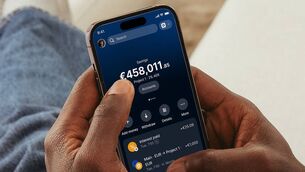Third of phone time spent on games

Smartphone users will spend €80bn this year on apps. Of this, 35% will be dedicated to gaming, according to Ivan Fernandez Lobo, the founder of Gamelab, who was speaking at the Mobile World Congress in Barcelona. He said 33% of the time people spend on their phone is passed by playing games.
“It’s simple,” said Aaron Rubenson, head of appstore product management at Amazon, in a panel discussion on mobile gaming. “Everybody loves games. Mobile devices are always with you. We all need entertainment.”
Yet 46% of the revenue mobile-gaming companies make comes from only 0.22% of its customers, according to Fernandez. “The industry depends so much on ‘whales’,” he said. The term whale is casino lingo for big spenders.
“We call them power users — customers who spend $50 a month or more in our store, compared to the industry average of $4 a month,” said Rubenson.
“These customers are incredibly loyal if you can find them. In the first month, they will typically spend about $100. They have great staying power. Even after 10 months, 70% will still be active and spending that baseline rate of $50. They’re loyal because this is their entertainment. You have to keep presenting them with offers to keep them engaged. It’s a very profitable segment to focus on.”
Nicolas Bereaudo, general manager of App Annie, said this behaviour is consistent with other sectors in the entertainment industry. “People who like music spend hours on end listening to music. It’s the same with people who like to watch films. In gaming, people want to pay for new content. If it’s only 2% of the market who are doing the bulk of that buying, and if you’re doing billions of dollars a year, where’s the problem? The good thing about mobile gaming for the customer is the value for money they get — the cost per hour of playing is lower than other entertainment forms. If you pay $1, you can play for tens of hours.”
Rubenson said because of their brand recognition, gaming companies could capitalise more on the customer base, especially in the area of merchandising.
“These gaming fans love the characters in the games,” he said. “They love the worlds created. They like to have real-world manifestations of these creations — they want to have T-shirts, soft toys, and jewellery. Developers who can offer them up are onto a triple win — it’s a new revenue source. You’ve delighted your fans. And then your fans become your marketers — they spread the word. The revenue that comes from inside the game is only part of it.”
Xavier Carrillo, the chief executive of Digital Legends Entertainment, said one of the interesting trends in the industry is the battle fought between devices for the consumer’s attention.
“There is a big war going on between consoles and your TV, tablets, and smartphones,” he said.
“Ultimately, people want to be able to choose. If you’re on a game while queuing for coffee, you get it on your phone. If you’re at the airport, you get it on your tablet. If you’re at home, you get it on your TV. Content at the end of the day should be mobile.”
The number of people with chronic diseases is rising as people live longer but integrated healthcare apps could help manage the conditions, according to Dr Yuri Quintana of the Harvard Medical School.
Speaking at yesterday’s Mobile World Congress in Barcelona, he said that when you have more than one chronic disease, there can be difficulties communicating between the two specialties. “If you develop an app for diabetes, for example, you need to understand how it will interact with data on other diseases like cardiovascular disease.”
.@yuriquintana from @Harvard on #USA #mHealth market #MWC15Health pic.twitter.com/6nhiIQII1S
— Global Health Connector (@ECHAlliance) March 4, 2015
Major chronic diseases are the cause of almost 60% of deaths in the world, according to the World Health Organisation, and account for approximately 80% of global health budgets, including $966bn in the US last year. These chronic diseases include heart disease, cancer and type-2 diabetes.
Dr Quintana said there are more than 40,000 so-called health apps on the market, although many of these are just “wellness or beauty apps”. In reality, there are about 10,000 healthcare apps, but fewer than 1,000 of these are integrated with healthcare systems.
Road ahead...#MWC15Health @yuriquintana pic.twitter.com/movi8dToKJ
— Imma Grau (@Inma_Grau) March 4, 2015
Dr Quintana stressed that physicians — or general practitioners — are the primary gatekeepers to the medical system. Often they are not being well served by technology system providers who, he said, sometimes add to rather than simplify administrative workloads.
Meanwhile, QualComm, in partnership with Trice, won the conference’s Best Mobile Innovation in Health award for its mobile ultrasound imaging solution.
The product was conceived to speed up second opinions in the medical field. It has deployed successfully in remote regions such as rural Morocco where specialists including doctors, nurses and midwives have used mobile devices to carry out diagnoses in less than 24 hours that would normally take two weeks.














